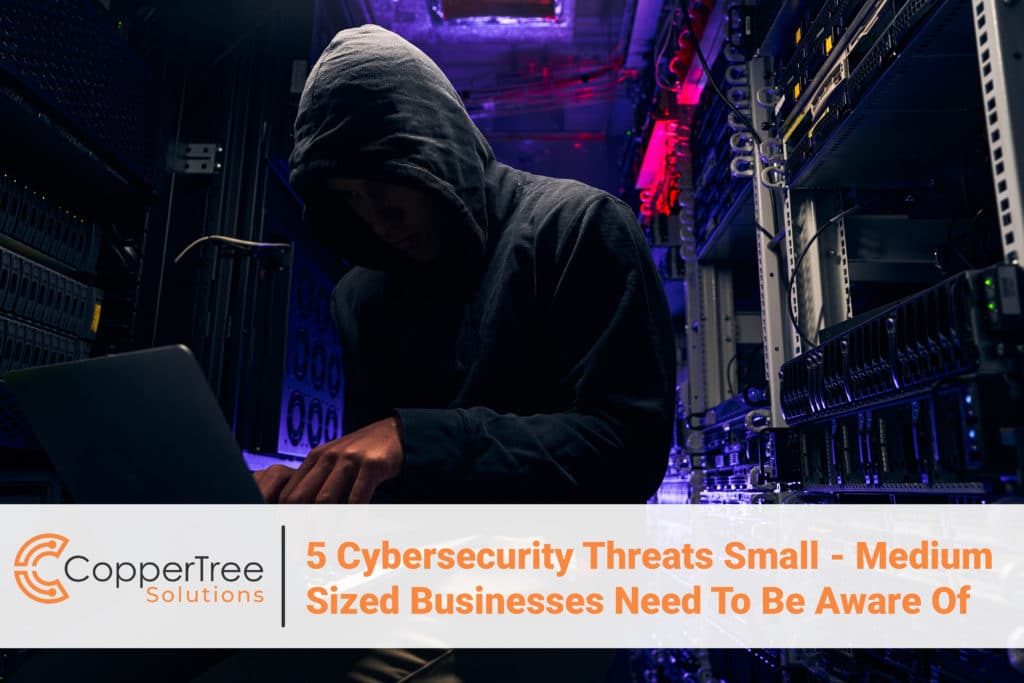
5 Cybersecurity Threats That Small to Medium Sized Businesses Face
5 Cybersecurity Threats That Small to Medium Sized Businesses Face

Cyber threats. Do small to medium-sized businesses need to worry about them? While large enterprises usually have more robust cybersecurity defenses, small businesses often lack the resources to adequately protect themselves. Cybercriminals are aware of this imbalance, and they are increasingly targeting smaller businesses. According to the 2020 Verizon Data Breach Investigations Report, 28% of all data breaches involved small businesses. Let’s look at five common cyber threats that small to medium-sized businesses should be aware of, as well as tips on how to protect against them.
1. Phishing Attacks
This type of attack is the most common and usually comes in the form of an email that appears to be from a trusted source, such as a bank or a social media site. The official-looking email will ask the recipient to click on a link, which will take them to a fake website. Here, they’ll be asked to enter their personal information, such as username, password, or credit card details.
Educating their employees on how to identify phishing emails is the first line of defense against these attacks. Secondly, businesses should implement email filtering software that can identify and block phishing emails before they reach employees’ inboxes. In addition, companies need to ensure that all exploitable software is up-to-date, including browsers, operating systems, and plugins.
2. Malware
Software that’s designed to damage or disable computers, networks, and other devices, is known as malware. Malware can be delivered in a number of ways, such as through email attachments or downloads from infected websites. Once malware gets installed on a computer, it can be used to steal sensitive data or it can launch further attacks on the business’s network.
To protect against malware, all business devices must be protected by antivirus software. Companies should also implement a policy of regularly scanning for malware and removing any infections. Another essential defense is educating employees on safe browsing practices and the risks of downloading software from untrustworthy sources.
3. Ransomware
Ransomware is a specific type of malware. It encrypts files on a computer or network, making them inaccessible to the owner. The hacker then demands a ransom payment in exchange for the decryption key. Ransomware attacks can be particularly damaging to smaller businesses, as they may not have the resources to recover from the attack without paying the ransom.
To defend against ransomware, businesses need to use the malware defense tactics of implementing antivirus software and educating employees. In addition, there needs to be a firm policy of backing up all data on a regular basis.
4. Insider Threats
Cyber threats that come from within the organization, such as from employees or contractors, are known as insider threats. These threats can include stealing sensitive data, intentionally damaging systems, or accidentally causing security breaches. Insider threats can be very difficult to detect, because the perpetrator already has access to the business’s systems and data.
There are two steps to protecting against insider threats. One is to implement strict access controls, ensuring that employees only have access to the data and systems they need to perform their job functions. And the second is to implement monitoring systems that can detect unusual activity on the network and immediately investigate any behaviour that appears suspicious.
5. (DDoS) Attacks
DDoS attacks (Distributed Denial of Service) occur when a hacker floods a website or network with traffic, making it unavailable to users. These cyber attacks can be especially damaging for smaller businesses because they do not have the resources to handle large traffic volumes. A DDoS attack can also be used as a diversionary tactic that distracts businesses from other attacks, such as malware or ransomware.
How to protect against DDoS attacks? Businesses need to implement a content delivery network (CDN) or other DDoS protection service. They should also ensure that their website and network infrastructure are configured correctly, as well as identifying and patching any vulnerabilities.
Stay Safe with Cybersecurity Experts
For any company, cybersecurity must be a top priority as all of these threats could potentially arise. The good news is that there are proactive steps businesses can take to protect themselves and minimize the risk of a data breach or cyber attack.
If you’re unsure whether your organization is adequately protected, don’t hesitate to take action. Here at CopperTree Solutions, our cybersecurity experts can help you assess your current security posture and develop a comprehensive cybersecurity plan tailored to your business’s unique needs. Contact us today to learn more about how we can help you protect your business against cyber threats.




